Author Archives: Holly Christensen
Author Archives: Holly Christensen
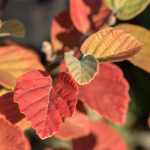
...and I don't mean cider or donuts. No, it's COLOR TIME!
Mums. Burning bush. Maple trees! You can probably name a dozen fall color plants without even thinking about it. But what about choosing from some of the lesser-known plants that also shine every autumn? Here are my top ten favorite fall color plants that may not be on your radar.

Oakleaf Hydrangea

Itea

Fothergilla

Panicum

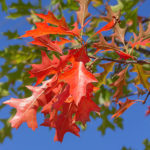
Various parts of the country are known for their vibrant displays of fall foliage colors, none more so than the Midwest, and in particular, Michigan. It seems odd that we get such joy from the annual death of leaves from deciduous trees, shrubs, and even some perennials. Why do leaves change colors in the fall, and why can’t we guarantee that fall color to our customers?
I'm going to super-simplify the scientific part of this explanation so here goes:
During spring and summer chlorophyll masks the other pigments so you pretty much just see green, however shorter days, longer nights, and cooler temperatures trigger an abscission layer to form, cutting off the flow of sugars and replacement chlorophyll. As the green color fades, the underlying yellow and orange colors are revealed, and reds and purples develop. Eventually all the colors break down, leaving brown tannins.
What colors are produced, and in what amounts, and when in relation to other plants, is due to the genetics of a particular plant, growing conditions, and weather.
Similar environmental conditions as those causing red color in leaves also may cause fall colors to come sooner, or later, or to last longer some years than others. Drought during spring and early summer may signal the plant to form the abscission layer early, shutting down growth and causing color change sooner than usual.
So while moisture is good earlier in the season, too much late in the season means more clouds, less sun, and more muted colors. Too much rain in fall plus strong winds, may cause many leaves to fall prematurely. Cooler temperatures in late summer, and plenty of sunshine, often leads to brighter colors sooner. Cool is good, but too cold (freezing) can be bad, killing leaves early.
So ideal for fall color would be a moist growing season early, dry late summer and early fall, with sunny warm days and cool nights during the latter.
Choosing cultivars with known fall color-producing ability will certainly help, but as you can see there are other factors that come into play, and you really cannot guarantee fall color.

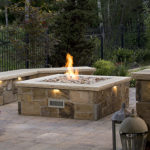
That’s what they say when they light your Saganaki cheese with a lighter and it erupts into a fireball from the brandy they poured on prior to serving. Just as the flames die out, they squeeze some fresh lemon juice to extinguish the last of the flames and add some zest. I am not a big fan of that particular cheese dish, but I sure do love that fireball! I’m not the only one who loves to watch this blazing spectacle, as surely half or more of the restaurant’s patrons are watching too. I believe it’s the fascination of watching a controlled ball of fire in a public place.
Natural gas or propane fire pits and fireplaces are becoming more popular with each passing year, and our partner Firegear Outdoors is leading the way. Their products offer a variety of controls and safety features that the wood burning counterparts do not. Some examples are push button ignition and remote controlled ignition that can be linked to work with swimming pool controls. Safety features such as a flame sensing automatic shutoff if the flame happens to go out and easily accessible valves to shut off the gas to the unit. I like the convenience of being able to simply turn it off, and not have to wait for the fire to die by itself. You will no longer have to buy and store wood, and best of all, you have virtually no maintenance! The list goes on and on, and with many different types and styles, your choices are almost limitless. They even have a portable fire pits for the convenience of mobility.
Installation and design can appear to be complicated, but in reality it’s a breeze! Firegear offers many product resources such as help guides that show from start to finish including specs and diagrams. They have a tech help line number to call that has a real live person on the other end to help answer more complicated questions, or help walk you through trouble shooting a problem. Firegear Outdoors offers complete kits or just burning systems for just about everything. If you have something unique in mind Firegear will do custom work to create the perfect fire feature for you.
One of the only drawbacks to a natural gas fire pit or fireplace is the reduced amount of heat that they produce. Natural gas and propane burn at a cooler temperature, which is one of the reasons you can decorate the bottom of the kit with ceramic logs, reflective glass pieces or a glass enclosure. These units were designed for ambiance, not cooking or heat distribution. With that being said, they will still keep you toasty on a crisp fall night.
So pull up a chair, get a tasty beverage and enjoy some fire with the snap of a finger and push of a button. And don’t forget to see us at the Hardscape Center; we can help you decide which buttons to push!

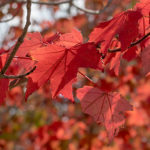
It’s almost that time of year for digging trees. There are some risks when it comes to fall digging season and you might be wondering what those risks are and what is safe to dig.
When handled correctly, many trees can be safely moved in the fall; however we have a list of trees that are considered poor candidates.
Christensen's Plant Center Fall Digging Hazard Trees
For instance, if a freshly-dug tree is slow at regenerating roots or lacks new established roots, that tree could be considered high risk. Thin-barked twiggy trees like birch and willow are also at high risk due to having trouble retaining moisture during the winter months. Fall planted trees of any species still require water going into the winter and many losses can be blamed on the tree drying out.
Even though Red maple is on the Fall Hazard list, the Freeman Maple hybrids (Acer x freemanii ) like Autumn Blaze® (‘Jeffersred’) are not considered a poor risk. Being a cross between silver and red maple, they are tough, fast growing, adaptable trees. They are drought tolerant when established and hardy to Zone 3, making them good candidates for fall digging. Norway (Acer platanoides) and Sugar (Acer saccharum) maple also tend to move well in the fall.
Some others to consider are Ginkgo and ‘Ivory Silk’ Tree Lilac (Syringa reticulata) - even though that last is not technically a shade tree we do see demand for them in landscapes where space is at a premium.
Any of our knowledgeable staff would be happy to help answer questions or give you the most suitable substitutions regarding fall hazard trees.
Visit these links for more information about Fall Hazard trees:
Fall Hazard tree lists explained (Sticks & Stones, Jeff Good)

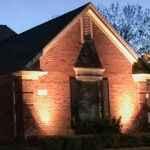
If you read last week's post you know how easy it is to figure out what transformer to spec when you're designing with LED fixtures. Now we'd like to help you out some more by giving away FREE Sollos Modern Bullet fixtures - one for every $500 you spend on lighting at CPC.
These are one of our most popular fixtures and can be used in virtually any lighting installation. We're letting you know about this promotion today so you can lay out your lighting scheme in plenty of time to take advantage of this giveaway!
This is a limited time offer that runs from September 10th through the 22nd, 2018.
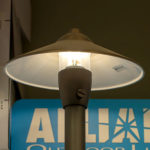
...when it comes to landscape lighting.
Remember a few years back when the “New Math” technique was introduced to classrooms? I don’t know if it’s pursued any more, and I hope it isn’t, because it was a LOT of unnecessary steps to get to a bottom line when the old way was much more efficient, in my opinion.
Now let’s talk some “New Math” with lighting. To get optimal performance from halogen and incandescent systems, here’s some “Old Math” formulas you either have to have memorized, have a cheat sheet, or use a manufacturer's system calculator. You do this in order to figure out EXACTLY what voltage tap to use on a transformer to reach that sweet spot between 10.8 and 12 Volts per fixture, using the HUB connection method:
First calculation: Watts / Volts = Amps
Then: Amps x Distance x (2 x Resistance per Foot) = Voltage Drop
Oh, wait, you'll need this in order to get that last variable (Resistance per Foot):
So, if you have five 20 watt halogen fixtures going 100 feet and using 12 gauge wire:
So the transformer needed for halogen or incandescent lighting, you would either have to use the 15 Volt tap, or remove 1 fixture from wire. 10 gauge wasn’t too bad to work with, but 8 gauge was a nightmare. Most contractors would have cheater formulas in their heads, such as if a run was 100’ or less, then you would use 12-2 wire, or if it was longer, use 10-2 wire. You get the idea.
Now that we got through “Old Math”, here’s “New Math” when using LEDs. DID YOU KNOW that an LED’s “sweet spot” isn’t between 10.8 and 12 volts? Instead, it’s between 8 and 24 volts per fixture, which means there’s a LOT of wiggle room! LED lamps have a far less draw on wattage as compared to their halogen & incandescent cousins, and will have equivalent or superior lumen output.
Quick example: Depending on the manufacturer, a standard JC20 LED lamp running between 2-3 watts has an output between 200 and 250 lumens - equal to or better than a 20 watt halogen that will likely max out at 200. Less draw = less resistance on a wire run. Less resistance = lesser gauge wire. This also means that you don’t need all those taps in a transformer, which normally means the transformer costs less. One tap should more than cover any run you have using 14-2 gauge wire. If you’re doing wire runs longer than 150’, you can always play it safe and bump up to a 12-2 gauge wire and that will solve the issue.
In conclusion, at least in my twisted opinion, when installing/designing a lighting system, the “Old Math” halogen methods are near obsolete as compared to LED’s “New Math”, meaning that it isn’t really necessary any more, due to advances in modern technology, and it will only improve from here. “New Math” outside of the landscape lighting world however… I can figure out 12 x 10 in my head instead of writing out a 12 part equation.

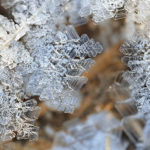
I don't want to bum you out, but winter is just around the corner.
I know, I know. It is the end of August. You have eight more weeks of landscape work left. And I am REALLY happy about that. In fact I wish you had twelve! But the reality is that by mid-November you are wrapping up your jobs and are planning your winter.
But I have a crazy suggestion. Start planning your winter now.
I was talking to my friend Chris Koontz from Carleton Equipment a few weeks ago, and he shared how busy Bobcat was. They are so busy they are taking many weeks to deliver new machines to customers. When I asked why, I was sort of shocked at the answer. Currently, build dates for new machines have been filled by dealers across the country for between four and six weeks. Not shocking. The shocking part was that it is taking ANOTHER three weeks to get the machine shipped from the factory to the dealer due to a lack of trucking. A new machine can take up to nine weeks to be delivered to you! He went on to say that other manufacturers are having the same issue. I believe him - it took two months to receive the new Kubota tractor we just bought.
So if you finish reading this article and call Carleton Equipment (for example) and order your machine today, you might not receive it until Halloween. If you wait until the end of the month, you will get your machine in time for deer season. If you wait until after Labor Day, you will have it in early December. See the trend? If you wait until Halloween to plan your winter, you will get your winter equipment after the New Year.
So don’t wait to plan your winter. Ordering equipment NOW is the smart play. Take advantage of financing. Avoid the end of the year rush. Be ahead of everyone else.
P.S. Carleton Equipment got snowplows in the first week of August. What are you waiting for?

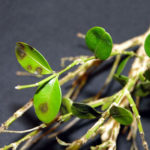
You may have heard of a new fungus that has been damaging and killing boxwood in the US. It was first identified in Connecticut in 2011. Called Boxwood Blight, it has now been seen as near as Ohio. It has been predicted that it will continue to spread. Spores can be transferred by physical contact, splashing water, or wind.
Christensen’s Plant Center is taking the necessary steps to make sure that we have clean boxwood in stock for you at all times. This means following the best practices that have come from growers and distributors across the country.
Boxwood Blight is easily transferred by physical contact. Even brushing up against an infected plant means that you can transfer the fungus onto other plants later that day. To that end we must ask that you observe the following when visiting Christensen’s Plant Center.
These practices are for your success as well as our own. Maintaining a clean facility ensures that we will be able to provide you with material that is free of Boxwood Blight for all of your projects now and in the future. Thank you for your help!
In the links below are PDFs with more information about this disease.
MSU Extension - Boxwood Blight Disease in North America (2.33 MB)
CAES - Boxwood Blight - A new disease for Connecticut and the U.S. (1.05 MB)
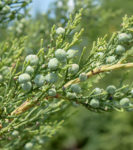
Guess what! We sell these! I don’t care how you say ‘em or spell ‘em as long as your check clears. I’m pretty sure my boss would agree with me. Hardly a day goes by that we don’t get contractor lists of hybridized and spell-’em-as-you-hear-’em names. I personally love the challenge! And yes, we do sell junipers - and yews.
In particular, Christensen’s sells a number of species of upright Junipers, the Eastern Redcedar. They are somewhat interchangeable with Arborvitae. Junipers require and tolerate hot, dry, sunny conditions but can have difficulties in poorly drained areas. They can be planted as backdrop accent evergreens or hedged into a living fence. A caveat is to avoid planting them too close to some members of the Rose family such as Crabs, Pears, Hawthorn, and Quince due to host/parasite rust occurrences.
The species of Juniperus that Christensen’s typically stocks are:
J. virginiana
J. chinensis
J. scopulorum (Rocky Mountain Junipers)
Availability for this genus is not quite as reliable as Arborvitae. We usually see periodic waves of uprights appear throughout the season. Junipers do, however, offer a greater range of color when compared to Arborvitae.
Next time you need an upright evergreen, ask to see some of the varieties just mentioned. Exact spelling not required!

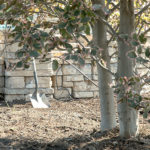
Should I be fertilizing my trees and shrubs in August?
Ask five experts that question and be prepared for five different answers, at least that happened to me. Regardless of the type or size of your new landscape, maintenance will be required to ensure it stays healthy and looking the way it was designed to look. Although 95% of all problems with new plant material can be attributed to improper watering, fertilizers are going to play a big part in getting things established and staying healthy.
Early spring and late fall are obviously your major fertilizing moments, but let's look at right now. New plantings will be aided by the use of some starter fertilizer, especially at new housing and businesses where a lot of good soil has been stripped away. Some cities have poor soil to begin with, lacking nutrients to give plants a good start. We carry some great organic starter fertilizer containing bacteria and mycorrhizae to increase root mass and help avoid transplant loss due to difficult conditions. Light application of these starters and plenty of water will be key during this month.
Fertilizing established plants in August is a little tricky. To avoid stressing the plant, avoid fertilizing during drought or heatwave conditions. Know your soil and fertilize only when plants are truly nutrient deficient. Why? Because new growth forced by fertilizing during this period may not harden off before the onset of winter resulting in tip dieback that won't show until next spring sometime. That's a phone call you won't want to get!
Come by our store and we will help you choose the best product for your particular situation.
